
Since walking is the most common form of exercise and great for both overall health and reaching weight loss goals, we have created a walking to lose weight chart (kg and km) and another chart for miles and lbs depending on what measurement system you’re familiar with.
The full chart can be seen below since the image above is just a preview.
Whether you’re just beginning or a seasoned walker, we’ll delve into details such as step tracking vs miles walked, the metabolic rate of tasks for walking, how much walking per BMI, and much more.
On top of providing charts in the metric and customary units, we’ve created a few other charts to show long term weight loss potential, calories burned, and approximate time and distance needed to reach your goals.
What Is the Ideal Amount of Walking for Weight Loss?
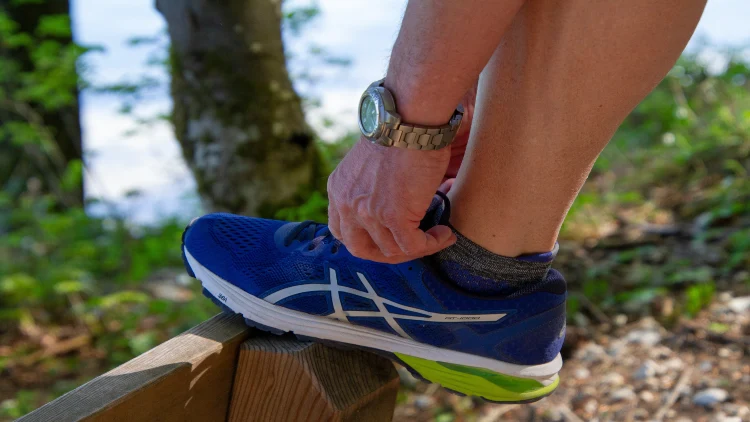
Source: ID 5598375 from Pixabay1
Many avid walkers or those beginning a weight loss journey may wonder about the amount of walking necessary to lose weight. How much walking to lose weight is variable dependent upon many factors including one’s starting weight, activity levels, pace, and much more but we’ll get into that further on.
We’ll also give helpful charts, actionable steps to take for increasing weight loss and calorie burning, as well as fun tips to make walking more enjoyable.
Walking is a key component of the three steps to lose weight and is accessible to a wide range of individuals. It doesn’t necessitate a specific speed or intensity and can be done at one’s own pace; as long as someone can walk, they can tailor the pace, distance, and intensity according to their capabilities and preferences.
For instance, individuals interested in losing weight by walking 2 miles a day, aiming to lose weight by walking 3 miles daily, or training for endurance with 5-10 miles a day or more can all gain numerous health benefits from walking. The beauty of walking is its versatility to meet various fitness goals and that it can be adaptable to most.
For a more organized approach to walking for weight loss, charts like the one below can be used to reach walking and weight loss benchmarks. Feel free to create your own version based on ability, endurance, and pace, but this is a sample walking to lose weight chart and we’ve provided both kg and km and a separate chart for lbs and miles.
Walking Benchmarks for Weight Loss (Steps, Distance, Time, Calories Burned & Weight Lost in Kgs & Pounds)
For this walking to lose weight chart, we’ve calculated the correlation between miles walked, steps taken, calories burned, hours spent, and how much weight can be lost each week given the amount of walking put in.
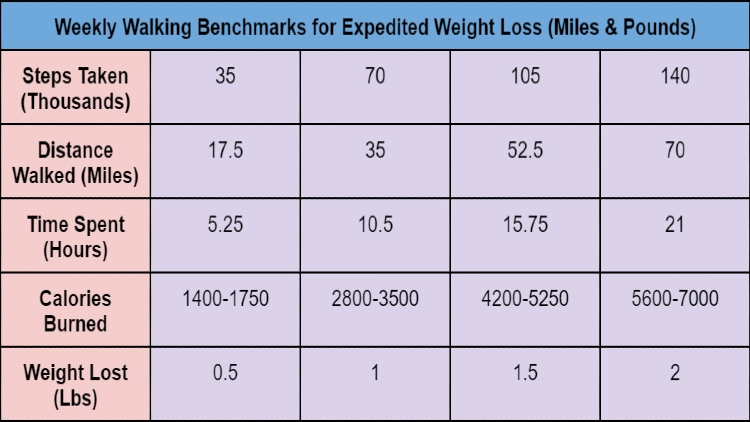
Note that the steps taken are by the thousands and that significant weight can be lost over time following any of these step goals, but that the more steps taken, of course the more calories that will be burned–meaning greater weight loss overall.
Next, we have our walking to lose weight chart offered in kg and kilometers for those who are more familiar with the metric system.2
While these walking goals could be achieved by walking greater distances just a few times each week, we recommend walking daily not only to build more consistent habits, but also so that weekly goals can more easily be met by distributing walking over each day.
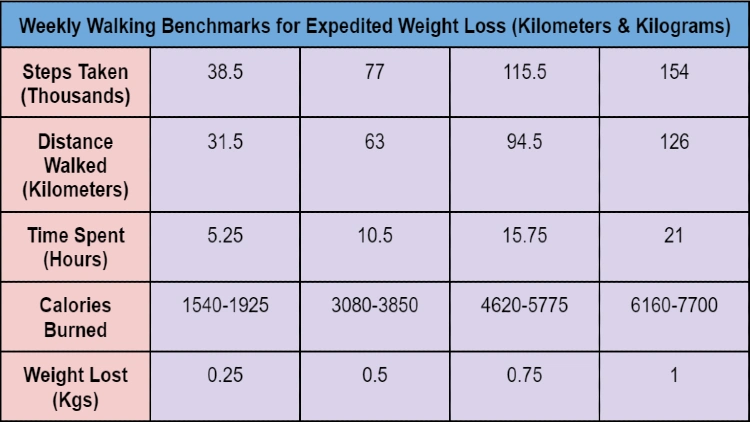
Understanding How Many Calories Walking Burns: Metabolic Energy of Task (MET) for Walking
The metabolic energy of task (MET)–also called metabolic equivalent of task–can help us understand how much energy is used (calories burned) in various cardio and aerobic activities. The metabolic equivalents (METS) in exercise testing, exercise prescription, and evaluation of functional capacity are defined as the quantity of oxygen consumed while simply resting or sitting.3
The mathematical calculation for this is 3.5 ml of O2 per kg of body weight multiplied by minutes, and gives insight into the energy cost of various types of physical activity in contrast to resting.
To gain a better understanding of METs, it’s important to know that they can range from 1-9; the energy one uses while resting is considered 1 MET and the more intense the physical activity or exertion, the higher the MET. The ranges with examples of each follow:
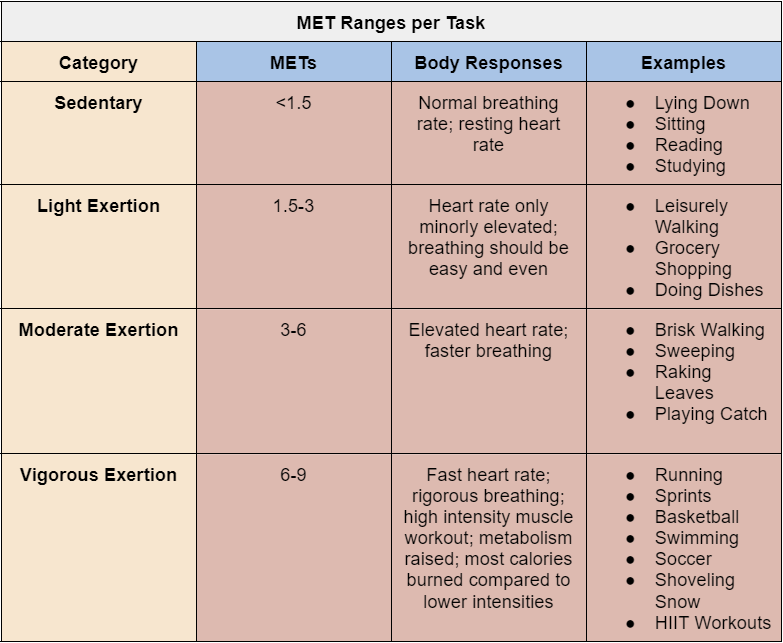
Calories Burned Walking Calculator
Those who have experimented with different weight loss diets are likely familiar with calorie tracking, but using a calculator to estimate calories burned while walking can also be a valuable tool for weight loss. In addition to assessing kg or pounds on a walking to lose weight chart, a calculator for calories burned in walking can also be useful in providing fairly accurate calculations that translate to overall weight loss.
The first calculator is set at an MET value of 3 which is a leisurely pace and approximately 3 miles per hour. Simply enter in your weight and the amount of time walked:
This next calculator is for those or prefer to power walk and is set at an MET of 4.5, although older adults may reach an MET more around 6 at this pace:
How Much Walking Is Needed To Lose 1 Pound of Fat?

Source: Ingo Jakubke from Pixabay4
Although this can vary somewhat depending on one’s stride, pace, and other variables, the average answer for how much walking is needed to lose 1 pound of fat or kilograms can be determined by figuring out how many calories are burned per unit of time or distance while walking.
Take a look at the following table with the assumption of a fairly leisurely walking pace and an average stride, which equates to about 2,000 steps per mile or 1,222 steps per kilometer walked.
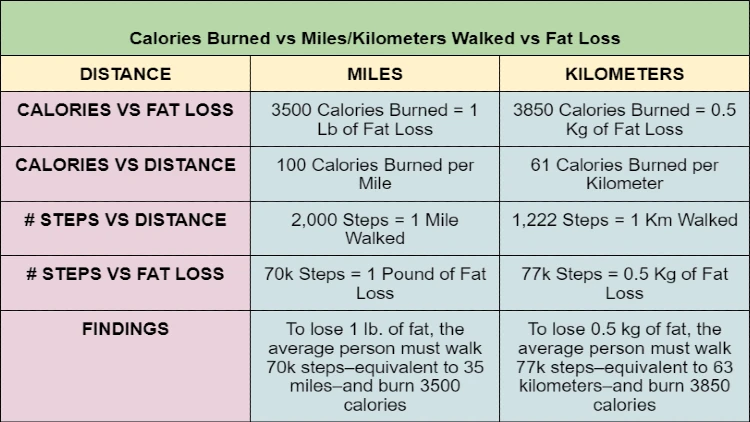
How To Burn More Calories While Walking
If unsatisfied with the calories burned while walking leisurely (from the walking weight loss chart above) and contemplating how to burn more calories while walking, rest assured that you can expedite weight loss by incorporating other challenges into your walking routines.
Those keen to learn ways to get skinny fast through walking can experiment with incorporating one or more of the following into their walking routine:
Walk on an incline: Far more muscles will be worked (and worked harder) when the body has to keep itself balanced and stabilized on an incline (or decline), therefore providing not only a more strenuous workout, but also raising the METs and burning more calories, allowing you to reach your weight loss goal sooner. However, this can be hard on those with previous knee pain or injuries.
Stay hydrated: Staying well-hydrated is crucial for everyone, but for those following a walking weight loss regimen, it’s essential to adhere to these weight loss guidelines, including hydrating before, during, and after walks to maintain healthy muscles and organs.
Stretch: Stretching is key to injury prevention; pulling a muscle can set someone back drastically in their fitness goals, so be sure to loosen up those muscles before and after a walk.
Track steps: The efficacy of wearable activity tracking technology as part of a weight loss program is very promising, with results showing that those who wear activity trackers are more successful in hitting their step goals, burning more calories, and losing more weight overall–at least in short term 6 month weight loss programs.5 Interestingly, younger adults who track steps versus those who don’t have little to no difference in weight loss, but middle aged and older adults have greater success with step tracking to meet their walking weight loss goals.
Use ankle or wrist weights: The added muscle exertion needed to move some extra weight whether it be 2 lb or 5 lb ankle weights helps burn more calories and makes walking for weight loss a greater challenge.
Pick up the pace: Lastly, a simple and effective way to exponentially increase calories burned through walking is to pick up the pace. While running or jogging obviously burn more, even upping the pace from leisurely to light or moderate exertion can burn far more calories.
Factors That Influence How Much Weight Can Be Lost Through Walking
Factors that can make weight loss through walking vary from person to person include any preexisting health conditions that may lower their walking speed or mobility, starting weight, previous activity levels, as well as how frequently one walks and the distance and exertion they put in.
What Is the Recommended Amount of Walking According to BMI?
There is no standard amount of walking a person should do in relation to their body mass index rating (BMI) since–due to the factors mentioned above–everyone has a different starting point and varying levels of mobility. However, we can give some general ranges of the amount of walking according to BMI and explain why this can be more helpful than simply going by the number on the scale.
BMI classification percentile and cut off points provide ranges or generalized levels of health based on a person’s height and weight, ranging from underweight to severely obese.6
An assessment of healthy lifestyles in relation to BMI found that a healthy BMI in the 18-25 window was more common in those with better education, including those who were still students.7 Interestingly, those with lower BMIs did not smoke but did consume alcohol occasionally, whereas the higher BMI group consisted of many former smokers who avoided alcohol completely.
Gender, lifestyle, and habits also had some impact but age did not seem to play much of a factor in these differences. These factors, as well as the scale’s inability to determine one’s height make BMI much more accurate for general health assessments.
Very generic guidelines based on an able-bodied person call for an average goal of 5 miles or 8 kilometers per day (about 10,000 steps), which can be split up into segments instead of done all at once, but it’s advised to do at least 30 minutes of walking at a time for the best cardiovascular health benefits.
Those who are just starting in their weight loss journeys or who are used to leading mostly sedentary lifestyles will likely need to build up to this benchmark and should start with a goal of 2,500 to 5,000 steps per day to begin and incrementally increase their walking over time. Those who might be more avid fitness enthusiasts and have no issue completing the 5 miles per day could try increasing the level of intensity by jogging or running, or continue walking but at an incline or with weights.
Health Benefits of Walking Regularly

Source: MabelAmber from Pixabay8
Health benefits of walking regularly abound, and even in a daily brisk 3 miles walk, calories are burned and weight is lost over time. Aside from weight loss, walking offers numerous benefits for both mental and physical health, and incorporating affirmations for achieving your dream body can help align your mindset with your fitness goals.
Some of the benefits of making walking a habit include:
- Stronger Muscles
- Improved Cardiovascular Health
- Release of Endorphins
- Greater Mental Clarity
- Reduced Depression & Anxiety
- Improved Endurance
- Greater Lung Capacity
- Increased Metabolism
- Expedited Weight Loss
- Toned Body
- Boosted Confidence
How To Achieve Long Term, Sustainable Weight Loss Through Walking
Someone starting their weight loss journey through walking may be pondering how long it takes to achieve their ideal body; while no exercise can create an overnight transformation, long-term, sustainable weight loss through walking is achievable. Some actions we recommend are:
- Use the calories burned walking calculator for each walk
- Determine walking goals based on ability, previous activity level, and BMI
- Remember to adjust walking goals as fitness levels and BMI change
- Reference our walking to lose weight chart (kg or lbs)
- Recruit a friend, family member, or colleague to be an accountability partner
- Don’t get discouraged if or when you hit a weight loss plateau
- Change up your routine often to keep it interesting (i.e. walk a new route)
- Be consistent
How Quickly Can I Lose Weight From Walking?
Experiencing frustration when weight loss slows down and questioning why only losing a pound a week is common, but aiming for 1-2 lbs of weight loss per week isn’t always realistic or applicable because it doesn’t account for starting weight, body fat composition, or other relevant factors.
Instead, those questioning the speed of weight loss from walking may be better off aiming for sustainable weight loss instead of rapid weight loss as slow, steady fat loss is proven time and again to stay off.
While integrating a dynamic and challenging walking regimen with one of several trending diets can accelerate weight loss, aiming to lose 1% of your total body weight each week is a commendable and more sustainable goal compared to rapid weight loss.
How Much Weight Can I Lose in a Year? (Long Term Walking To Lose Weight Chart–Lbs)
We’ve created a walking to lose weight chart (lbs) that shows how many steps and miles must be walked and how much time spent to achieve a pound of weight loss per week consistently for a year, with the assumption of a fairly leisurely pace (18 minutes per mile).
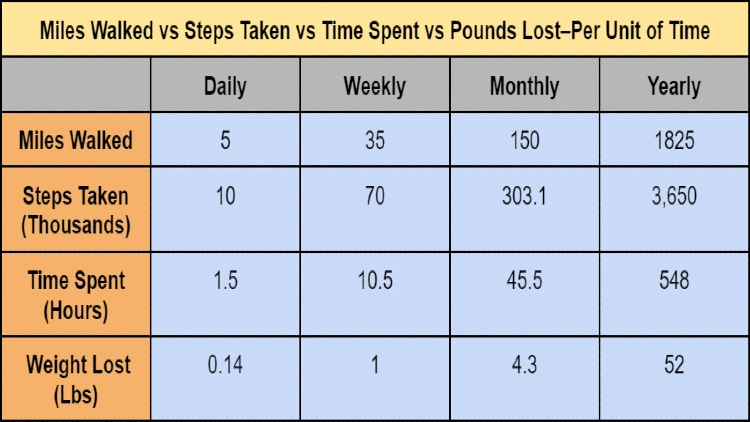
How Much Weight Can I Lose in a Year? (Long Term Walking To Lose Weight Chart–Kgs)
Similar to the one above, the only difference is that this walking to lose weight chart gives kg and km metrics instead of miles and pounds.
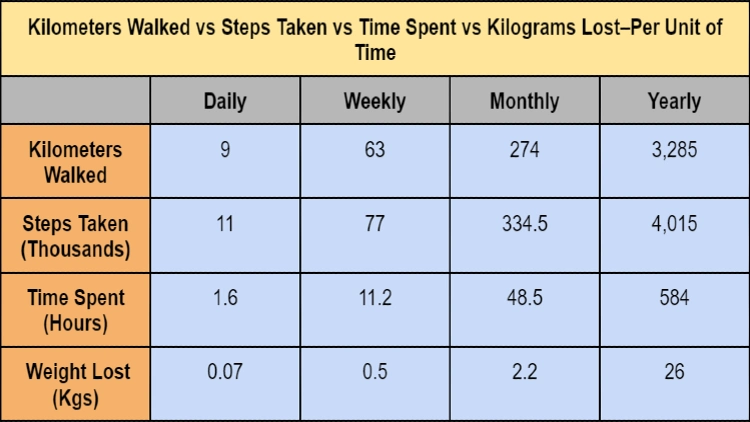
Walking can be beneficial in reaching weight loss targets and helping one become more healthy overall. By using our tools such as a calories burned calculator and our walking to lose weight chart (kg or lbs), one can better plan and track their progress to achieve their goal weight faster.
Frequently Asked Questions
How Can I Make Walking More Enjoyable?
To make walking more enjoyable, try walking outdoors, enjoying scenery, finding an accountability buddy, or listening to music, audiobooks, or podcasts.
How Many Pounds Can I Lose per Week by Walking Every Day?
It’s possible to lose more weight per week depending on walking exertion, distance, and calories burned, but we advise aiming for losing 1% of total body weight per week for best and lasting results.
What Types of Exercises Burn More Calories Than Walking?
Biking, swimming, jogging, running, HIIT workouts and other high intensity workouts can burn calories at a faster rate and help reach target weight faster.
References
1ID 5598375. “Sports Shoe – Free photo on Pixabay.” Pixabay, 22 April 2018, Accessed 6 April 2023. <https://pixabay.com/photos/sports-shoe-sports-shoe-running-3340598/>
2Wikipedia, the Free Encyclopedia. (2023, February 13). Metric System. Wikipedia. Retrieved February 24, 2023, from <https://en.wikipedia.org/wiki/Metric_system>
3Jette, M., Sidney, K., & Blumchen, G. (1990, August). Metabolic equivalents (METS) in exercise testing, exercise prescription, and evaluation of functional capacity. National Library of Medicine. Retrieved February 22, 2023, from <https://pubmed.ncbi.nlm.nih.gov/2204507/>
4Jakubke, Ingo. “Free Image on Pixabay – Overcast, Winter, Cloudy Day.” Pixabay, 26 January 2023, Accessed 6 April 2023. <https://pixabay.com/photos/overcast-winter-cloudy-day-clouds-7743510/>
5Cheatham, S., Stull, K., Fantigrass, M., & Motel, I. (2018, April). The efficacy of wearable activity tracking technology as part of a weight loss program: a systematic review. The Journal of Sports Medicine and Physical Fitness, 4(58), 534-548. <https://pubmed.ncbi.nlm.nih.gov/28488834/>
6Weir, C., & Jan, A. (2022). BMI Classification Percentile And Cut Off Points. StatPearls Publishing. <https://pubmed.ncbi.nlm.nih.gov/31082114/>
7Simkova, S., Dvorackova, O., & Velemsky, M. (2022, December 31). Assessment of healthy lifestyles in relation to BMI. National Library of Medicine. Retrieved February 22, 2023, from <https://pubmed.ncbi.nlm.nih.gov/36720128/>
8MabelAmber. “Love Couple Outdoors – Free photo on Pixabay.” Pixabay, 23 September 2018, Accessed 6 April 2023. <https://pixabay.com/photos/love-couple-outdoors-romance-man-3694475/>